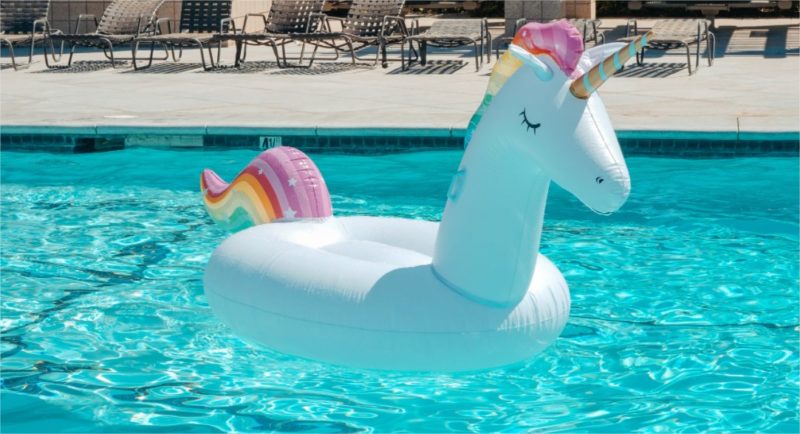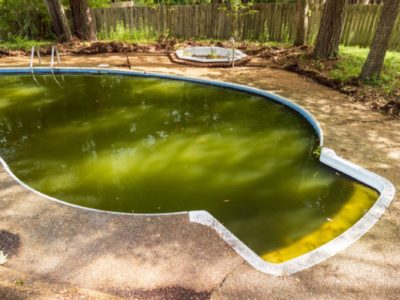How to Eliminate and Prevent Green Algae in a Swimming Pool / One of the biggest challenges of maintaining a swimming pool is to prevent algae growth. Even if the pool has an excellent filtration system and proper sanitation, eliminating green algae from the pool is a hard task.
What is Algae? Algae is an aquatic organism that grows on pools that are not properly maintained. The commonly found algae are green in color, though algae in black, pink and yellow are also found. It grows in both sun and shade and needs light to grow. Algae in a swimming pool affect its overall appearance, that swimmers hesitate to use it. Though algae are not dangerous as such, pools with algae can be a breeding ground for other types of pathogens like E-coli bacteria.
What Causes Algae in Pools?
Any of the below factors can cause algae in a pool.
- Poor water circulation
The water in a swimming pool should never be stagnant. If it does not circulate properly, or if the circulation is poor, it can result in the formation of algae.
- Poor water balance
The swimming pool water should have an ideal level of pH balance, calcium, alkalinity and cyanuric acid. If this balance is not maintained, it can result in the growth of algae.
- Poor sanitation
Adding chlorine to water not only eliminates dirt but also helps to kill bacteria and algae. If the pool does not have the correct level of chlorine, it can result in the formation of algae.
- Poor filtration
Filtration helps remove dirt and other debris in the water, which plays a crucial role in the formation of algae. Thus, if the water is not filtered or the filtration process is poor, it can result in algae growth.
How To Eliminate Algae In Swimming Pool?
As soon as you notice algae growth in your swimming pool, you should try to get rid of it. You can follow the below steps to eliminate algae.
- Check the water qualit.
First, you should check the water to see whether it has the right amount of chlorine, pH and stabilizer. If the balance is not maintained correctly, you should add the required chemicals to maintain the water quality. The pH level of water should always be maintained between 7.2 and 7.6.
- Clean the filter
The main function of the filter is to clear all the debris and sediments. If you have algae in the pool, the filter is more likely to have those sediments. You should clean the filter depending on what type it is.
- Brush the pool
With the help of a pool cleaning brush, you should thoroughly brush and clean the floor of the pool, the walls, and the step. Brushing and cleaning help to remove any algae that got stuck on the surface.
- Shock the pool
Shocking is the process of adding chemicals like chlorine at a high dose in the water. This helps to destroy algae and other bacteria in the pool. It is best to shock the pool during the evening or night as the sun’s rays can burn the chlorine off before killing the algae.
- Test the pool water
Once the shocking is done, you should check whether the water has proper chlorine and pH level. If chlorine level is very low, you should undertake the shocking process after a few days.
- Add algaecide
Algaecide is a chemical that helps to kill algae present in water. A day after the shocking is done, you should add algaecide to the pool and leave it for 24 hours. Adding algaecide helps to kill all the algae in the pool.
- Brush and vacuum the pool
Now brush the pool once more to remove all traces of algae. Remember to brush all parts of the pool, including the steps. Use a pool vacuum cleaner to suck out algae and other debris.
- Run the filter
Once the whole process is over, you should continuously run the filter for a day to clear the water.
How To Prevent Green Algae in Swimming Pool?
- Good circulation system
The pool should have a good circulation system to prevent the growth of algae. You should regularly check the skimmer and pump strainer basket and clean it. This helps the water and sanitising chemicals flow throughout the pool.
Along with this, you should also clean the pool filter at regular intervals. Over time, the filter gets clogged with debris and sand. Cleaning them regularly ensures that the pool remains clean.
- Maintain the sanitizer level
Green algae grow continuously in the pool. But they can be kept under control through the use of sanitizer or chlorine. Thus, you should check the sanitiser at regular intervals to ensure that they are maintained at the prescribed level.
Using a floating or an automatic chlorinator is the best way to maintain the chlorine level in the pool.
- Shock the pool regularly
The pool should be shocked at least once a week to prevent the growth of algae. Shocking helps to keep the pool clean and kills the algae before it grows.
- Clean the pool regularly
Cleaning the pool through regular brushing helps to prevent the growth of algae. You should pay special attention to all parts of the pool, including the floor, wall and steps. Brushing prevents the algae from burrowing the root inside small cracks, which later becomes very difficult to remove.
Once the pool is brushed, you should vacuum it thoroughly. While brushing, algae and other debris separate from the surface and settle at the bottom of the pool. This should be vacuumed and cleaned thoroughly to prevent further growth of algae.
Conclusion
Algae can grow anytime and destroy the very appearance of the pool. Thus, you must keep a watchful eye on the pool year round. You should maintain a weekly cleaning schedule and try to stick to it. Special attention should be paid to the ladder and step as algae growth in these areas can go unnoticed. Maintaining a neat and clean pool is the solution to all your algae problems.






